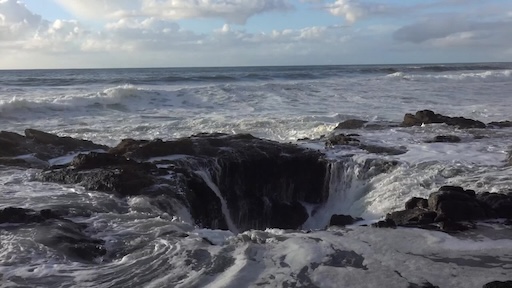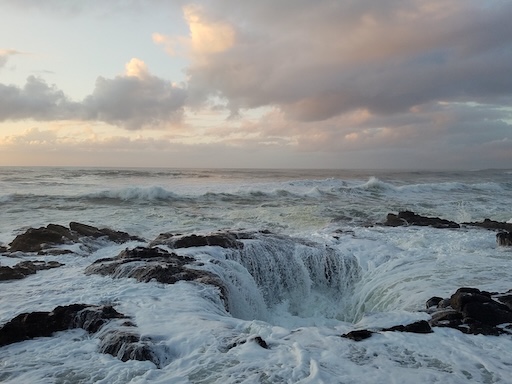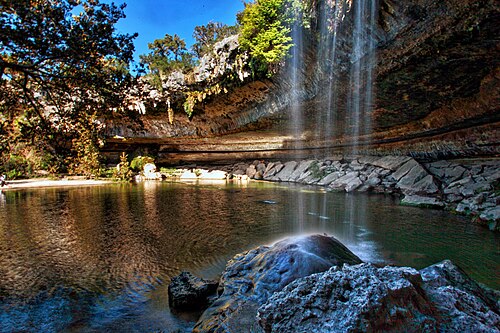
Along the wave-battered coast of USA’s Pacific Northwest, just south of Yachats, Oregon, there’s a place where the sea seems to vanish. Not metaphorically—but literally. A foamy rush of ocean crashes into jagged black rock, swirls, and then plunges into a gaping hole in the earth. Locals call it Thor’s Well. Travelers call it mesmerizing. Scientists call it a collapsed sea cave. But stand beside it during high tide and you'll likely call it something else: terrifyingly beautiful.
Nicknamed the “drainpipe of the Pacific,” Thor’s Well is one of the most surreal spectacles on the Oregon Coast—a place where Poseidon seems to inhale the ocean with every crashing wave. You don’t just see this wonder. You feel it in your bones.
A Hole That Breathes
What exactly is Thor’s Well? In simple terms, it’s a large, circular hole in the volcanic rock shelf near Cape Perpetua. But the drama unfolds when the tides rise. As waves crash over the rim, the water erupts skyward—only to be sucked violently back down into the “well.” It’s like the earth is breathing. In. Out. In. Out. Sometimes gentle. Sometimes roaring like a beast.

The well itself is only about 20 feet deep, but the illusion it creates during high tide makes it feel infinite. Water comes in from the top and from an underwater tunnel, resulting in a chaotic push-pull that looks like the ocean is being swallowed whole.
Born of Fire and Fury
Like many of Oregon’s coastal oddities, Thor’s Well was born of ancient lava. This region sits atop basalt rock—volcanic in origin—and over thousands of years, relentless waves carved out a sea cave. Eventually, the cave's roof collapsed, creating what looks like a sinkhole right at the ocean’s edge.
Unlike some mythical places with mysterious origins, Thor’s Well is entirely natural—but that doesn't make it less magical. Standing nearby, especially during stormy weather, it’s easy to imagine Norse gods battling beneath the sea. No wonder someone named it after Thor.
The Perfect Storm for Photography
For photographers, Thor’s Well is the kind of place you dream of. The drama. The contrast. The sheer unpredictability. At sunset, with waves crashing and skies ablaze in color, it's hard to take a bad photo. But you’ll need to be quick—and careful.
The best times to shoot are about one hour before high tide or during a rising tide, when water activity is at its peak. Long exposure shots can turn the fury into art—making the chaos look like ocean mist descending into the earth.

Warning: This Beauty Bites
Thor’s Well might be beautiful, but it’s also brutally dangerous. Countless signs warn visitors to stay back, especially during storm surges. Rogue waves have swept people off the rocks and into the surf. Even experienced hikers and photographers have been caught off guard.
The rocks are slick. The waves are fast. And Thor’s Well doesn’t care about your camera gear or your hiking boots. Some days, it gently gurgles. Other days, it roars like it wants to pull the entire ocean into the underworld. Respect is not optional—it’s essential.
Planning Your Visit
- Location: Cape Perpetua Scenic Area, about 3 miles south of Yachats, Oregon.
- Best Time to Visit: 1 hour before high tide during calm weather. Sunset adds drama.
- Parking: Thor’s Well is accessible from the Cook’s Chasm pullout off Highway 101.
- Trail: Short hike from the parking area. Follow signs to the viewing area.
- Safety: Wear waterproof shoes, stay far from the edge, and never turn your back on the ocean.
Beyond the Well
While Thor’s Well gets the spotlight, the surrounding area is full of wonder. Just steps away you’ll find the Spouting Horn, a natural blowhole that shoots water high into the air through a rock fissure. And just to the north, the tidepools of Cook’s Chasm reveal marine life in all its alien glory—urchins, starfish, sea anemones.
The Cape Perpetua Scenic Area also offers several miles of trails that lead through coastal forest, old-growth Sitka spruce, and dramatic cliffside overlooks. On a clear day, you can see 70 miles of coastline and maybe even spot a migrating gray whale offshore.
Why It Haunts You (In the Best Way)
There’s something eerie about Thor’s Well that stays with you. Maybe it’s the sound—the endless boom and gulp. Maybe it’s the way the sea disappears and reappears in rhythmic defiance. Or maybe it’s just the feeling of standing so close to something ancient and raw.
You won’t forget your first visit. People have described it as hypnotic, terrifying, awe-inspiring, even spiritual. It’s not just a place to photograph. It’s a place to witness. A live performance by Earth and sea.
If You Love Thor’s Well, You Might Also Like…
- Hamilton Pool Preserve (Texas) – A collapsed cave turned into a dreamy pool and waterfall.
- The Wave (Arizona) – A wind-carved sandstone marvel straight out of a dream.
- Devil’s Churn (Oregon) – Just south of Thor’s Well, a violent surf channel with thunderous crashes.
- Boiling Pots (Hawaii) – River pools that churn like cauldrons in Hilo after heavy rain.
- Hole in the Wall (California) – A natural arch where waves funnel through sea cliffs.
Final Thoughts
Thor’s Well isn’t just a cool spot on a coastal map—it’s a living, roaring reminder of nature’s power. It doesn't ask for attention. It demands it. And if you stand there long enough, letting the spray hit your face and the roar echo in your chest, you'll feel it—that primal connection to something bigger, older, and infinitely wilder than us.
Come for the spectacle. Stay for the reverence. Just don’t get too close.
Share this story and inspire others.
Tags: Thor's Well Oregon, Spouting Horn, Oregon coast wonders, natural sinkhole sea, USA ocean vortex
 Devils Tower – Wyoming`s Sacred Monolith and Sci-Fi Icon
Devils Tower – Wyoming`s Sacred Monolith and Sci-Fi Icon
 Hamilton Pool Preserve – Hidden Waterfall Oasis Near Austin
Hamilton Pool Preserve – Hidden Waterfall Oasis Near Austin
 The Wave – Surreal Sandstone Wonderland in Arizona
The Wave – Surreal Sandstone Wonderland in Arizona
 Apostle Islands Ice Caves – Wisconsin’s Frozen Cathedral on Lake Superior
Apostle Islands Ice Caves – Wisconsin’s Frozen Cathedral on Lake Superior
 Great Sand Dunes National Park – Colorado’s Surreal Desert at the Foot of the Rockies
Great Sand Dunes National Park – Colorado’s Surreal Desert at the Foot of the Rockies
 Skagit Valley Tulip Fields – Washington’s Springtime Dutch Fantasy
Skagit Valley Tulip Fields – Washington’s Springtime Dutch Fantasy